The Potential of Pig Sludge Fertilizer for Some Pasture Agricultural Lands’ Improvement: Case Study in Timiș County, Romania
Abstract
1. Introduction
2. Materials and Methods
2.1. General Characterization of the Area
2.2. General Climatic Conditions for the Area Characterization
2.3. General Soil Conditions for the Area Characterization
2.4. Description of the Pig Sludge Used
2.5. Soil Agrochemical Indices
2.6. Satellite Images
2.7. Statistical Data Processing
3. Results
3.1. Soil Characterization Based on Soil Profiles
3.2. Soil Characterization Based on Agrochemical Indices under the Influence of Pig Sludge
3.3. Variability of Pasture Lands Studied Based on NDVI under the Influence of Pig Sludge
4. Discussion
5. Conclusions
Author Contributions
Funding
Data Availability Statement
Acknowledgments
Conflicts of Interest
References
- Cole, M.B.; Augustin, M.A.; Robertson, M.J.; Manners, J.M. The science of food security. NPJ Sci. Food 2018, 2, 14. [Google Scholar] [CrossRef] [PubMed]
- Knorr, D.; Augustin, M.A.; Tiwari, B. Advancing the role of food processing for improved integration in sustainable food chains. Front. Nutr. 2020, 7, 34. [Google Scholar] [CrossRef]
- Vågsholm, I.; Arzoomand, N.S.; Boqvist, S. Food security, safety, and sustainability—getting the trade-offs right. Front. Sustain. Food Syst. 2020, 4, 16. [Google Scholar] [CrossRef]
- Van Dijk, M.; Morley, T.; Rau, M.L.; Saghai, Y. A meta-analysis of projected global food demand and population at risk of hunger for the period 2010–2050. Nat. Food 2021, 2, 494–501. [Google Scholar] [CrossRef]
- Pawlak, K.; Kołodziejczak, M. The role of agriculture in ensuring food security in developing countries: Considerations in the context of the problem of sustainable food production. Sustainability 2020, 12, 5488. [Google Scholar] [CrossRef]
- Friedrich, T.; Kassam, A. Food security as a function of sustainable intensification of crop production. AIMS Agric. Food 2016, 1, 227–238. [Google Scholar] [CrossRef]
- Kopittke, P.M.; Menzies, N.W.; Wang, P.; McKenna, B.A.; Lombi, E. Soil and the intensification of agriculture for global food security. Environ. Int. 2019, 132, 105078. [Google Scholar] [CrossRef] [PubMed]
- Jurgilevich, A.; Birge, T.; Kentala-Lehtonen, J.; Korhonen-Kurki, K.; Pietikäinen, J.; Saikku, L.; Schösler, H. Transition towards circular economy in the food system. Sustainability 2016, 8, 69. [Google Scholar] [CrossRef]
- Van Zanten, H.H.E.; van Ittersum, M.K.; de Boer, I.J.M. The role of farm animals in a circular food system. Glob. Food Sec. 2019, 21, 18–22. [Google Scholar] [CrossRef]
- Koppelmäki, K.; Helenius, J.; Schulte, R.P.O. Nested circularity in food systems: A Nordic case study on connecting biomass, nutrient and energy flows from field scale to continent. Resour. Conserv. Recycl. 2021, 164, 105218. [Google Scholar] [CrossRef]
- Mancini, M.C.; Arfini, F.; Antonioli, F.; Guareschi, M. Alternative agri-food systems under a market agencements approach: The case of multifunctional farming activity in a peri-urban area. Environments 2021, 8, 61. [Google Scholar] [CrossRef]
- Vicente-Vicente, J.L.; Doernberg, A.; Zasada, I.; Ludlow, D.; Staszek, D.; Bushell, J.; Hainoun, A.; Loibl, W.; Piorr, A. Exploring alternative pathways toward more sustainable regional food systems by foodshed assessment—City region examples from Vienna and Bristol. Environ. Sci. Policy 2021, 124, 401–412. [Google Scholar] [CrossRef]
- Roellig, M.; Sutcliffe, L.M.; Sammul, M.; von Wehrden, H.; Newig, J.; Fischer, J. Reviving wood-pastures for biodiversity and people: A case study from western Estonia. Ambio 2016, 45, 185–195. [Google Scholar] [CrossRef]
- Envall, I.; Bengtsson, J.; Jakobsson, S.; Rundlöf, M.; Åberg, C.; Lindborg, R. What is the effect of giving the grazers access to additional nutrient sources on biodiversity in semi-natural pastures? A systematic review protocol. Environ Evid. 2021, 10, 16. [Google Scholar] [CrossRef]
- Wezel, A.; Stöckli, S.; Tasser, E.; Nitsch, H.; Vincent, A. Good pastures, good meadows: Mountain farmers’ assessment, perceptions on ecosystem services, and proposals for biodiversity management. Sustainability 2021, 13, 5609. [Google Scholar] [CrossRef]
- Burak, D.L.; Monteiro, E.d.C.; Passos, R.R.; Mendonça, E.d.S. Soil quality index for extensive pastures in hilly landforms region of highly weathered soils in an Atlantic forest biome, Brazil. Afr. J. Range Forage Sci. 2021, 1–12. [Google Scholar] [CrossRef]
- Karaca, S.; Dengiz, O.; Turan, I.D.; Özkan, B.; Dedeoğlu, M.; Gülser, F.; Sargin, B.; Demirkaya, S.; Ay, A. An assessment of pasture soils quality based on multi-indicator weighting approaches in semi-arid ecosystem. Ecol. Indic. 2021, 121, 107001. [Google Scholar] [CrossRef]
- Sands, R.; Westcott, P.; Price, J.M.; Beckman, J.; Leibtag, E.; Lucier, G.; McBride, W.; McGranahan, D.; Morehart, M.; Roeger, E.; et al. Impacts of Higher Energy Prices on Agriculture and Rural Economies; ERR-123; U.S. Department of Agriculture, Economic Research Service: Washington, DC, USA, 2011. [Google Scholar]
- Choudhary, M.; Bailey, L.D.; Grant, C.A. Review of the use of swine manure in crop production: Effects on yield and composition and on soil and water quality. Waste Manag. Res. 1996, 14, 581–595. [Google Scholar] [CrossRef]
- Imbeah, M. Composting piggery waste: A review. Bioresour. Technol. 1998, 63, 197–203. [Google Scholar] [CrossRef]
- Santos, A.; Fangueiro, D.; Moral, R.; Bernal, M.P. Composts produced from pig slurry solids: Nutrient efficiency and N-leaching risks in amended soils. Front. Sustain. Food Syst. 2018, 2, 8. [Google Scholar] [CrossRef]
- Hlisnikovský, L.; Menšík, L.; Čermák, P.; Křížová, K.; Kunzová, E. Long-term effect of pig slurry and mineral fertilizer additions on soil nutrient content, field pea grain and straw yield under winter wheat–spring barley–field pea crop rotation on cambisol and luvisol. Land 2022, 11, 187. [Google Scholar] [CrossRef]
- Loyon, L. Overview of animal manure management for beef, pig, and poultry farms in France. Front. Sustain. Food Syst. 2018, 2, 36. [Google Scholar] [CrossRef]
- Park, S.H.; Lee, B.R.; Jung, K.H.; Kim, T.H. Acidification of pig slurry effects on ammonia and nitrous oxide emissions, nitrate leaching, and perennial ryegrass regrowth as estimated by 15N-urea flux. Asian-Australas. J. Anim. Sci. 2018, 31, 457–466. [Google Scholar] [CrossRef] [PubMed]
- Zhang, D.; Wang, X.; Zhou, Z. Impacts of small-scale industrialized swine farming on local soil, water and crop qualities in a Hilly Red soil region of Subtropical China. Int. J. Environ. Res. Public Health 2017, 14, 1524. [Google Scholar] [CrossRef]
- Venglovsky, J.; Sasakova, N.; Gregova, G.; Papajova, I.; Toth, F.; Szaboova, T. Devitalisation of pathogens in stored pig slurry and potential risk related to its application to agricultural soil. Environ. Sci. Pollut. Res. Int. 2018, 25, 21412–21419. [Google Scholar] [CrossRef] [PubMed]
- Terrero, M.A.; Muñoz, M.Á.; Faz, Á.; Gómez-López, M.D.; Acosta, J.A. Efficiency of an integrated purification system for pig slurry treatment under Mediterranean Climate. Agronomy 2020, 10, 208. [Google Scholar] [CrossRef]
- Zhang, Y.; Jiang, Y.; Wang, S.; Wang, Z.; Liu, Y.; Hu, Z.; Zhan, X. Environmental sustainability assessment of pig manure mono- and co-digestion and dynamic land application of the digestate. Renew. Sustain. Energ. Rev. 2021, 137, 110476. [Google Scholar] [CrossRef]
- Silva, H.L.d.C.E.; Barros, R.M.; Santos, I.F.S.d.; Lora, E.E.S.; Alcântara, M.A.K.d.; Andrade, R.V. A review of Brazilian agro-industrial pig farming systems: Environmental impacts and applied anaerobic digestion processes with mineral additives. Res. Soc. Dev. 2022, 11, e6811121720. [Google Scholar] [CrossRef]
- Poole, D.B.R.; McGrath, D.; Fleming, G.A.; Moore, W. Effects of applying copper-rich pig slurry to grassland: 4. Sheep feeding experiments. Irish J. Agric. Res. 1990, 29, 35–40. Available online: https://www.jstor.org/stable/25556253 (accessed on 19 January 2022).
- Stevens, C.G.; Ugese, F.D.; Baiyeri, K.P. Effect of pig manure on growth and productivity of twenty accessions of Moringa oleifera in Nigeria. Agro-Sci. J. Trop. Agric. Food Environ. Ext. 2018, 17, 19–26. [Google Scholar] [CrossRef][Green Version]
- Ndayegamye, A.; Côté, D. Effect of long-term pig slurry and solid cattle manure application on soil chemical and biological propenies. Can. J. Soil Sci. 1989, 69, 39–47. [Google Scholar] [CrossRef]
- Boitt, G.; Schmitt, D.E.; Gatiboni, L.C.; Wakelin, S.A.; Black, A.; Sacomori, W.; Cassol, P.C.; Condron, L.M. Fate of phosphorus applied to soil in pig slurry under cropping in southern Brazil. Geoderma 2018, 321, 164–172. [Google Scholar] [CrossRef]
- Ekane, N.; Barquet, K.; Rosemarin, A. Resources and risks: Perceptions on the application of sewage sludge on agricultural land in Sweden, a case study. Front. Sustain. Food Syst. 2021, 5, 647780. [Google Scholar] [CrossRef]
- FAOUN. World reference base for soil resources 2014. In International Soil Classification System for Naming Soils and Creating Legends for Soil Maps; Food and Agriculture Organization of the United Nations: Rome, Italy, 2014; ISBN 9789251083697. [Google Scholar]
- Florea, N.; Munteanu, I. Sistemul Roman de Taxonomie a Solului (SRTS); Editura Sitech: Craiova, Romania, 2012; ISBN 978-606-11-2090-1. [Google Scholar]
- Rouse, J.W.; Haas, R.H.; Schell, J.A.; Deering, D.W. Monitoring vegetation systems in the great plains with ERTS. In Proceedings of the Third Earth Resources Technology Satellite-1 Symposium, Greenbelt, MD, USA, 10–14 December 1974; pp. 3010–3017. [Google Scholar]
- Planet Team. Planet Application Program Interface: In Space for Life on Earth; Planet Team: San Francisco, CA, USA, 2017; Available online: https://api.planet.com (accessed on 10 December 2020).
- Hammer, Ø.; Harper, D.A.T.; Ryan, P.D. PAST: Paleontological statistics software package for education and data analysis. Palaeontol. Electron. 2001, 4, 1–9. [Google Scholar]
- ESRI. ArcGIS Desktop: Release 10; Environmental Systems Research Institute: Redlands, CA, USA, 2011. [Google Scholar]
- Yang, Y.R.; Li, X.G.; Zhou, Z.G.; Zhang, T.L.; Wang, X.X. Differential responses of soil nematode community to pig manure application levels in Ferric Acrisols. Sci. Rep. 2016, 6, 35334. [Google Scholar] [CrossRef]
- Seo, Y.H.; Cho, B.O.; Choi, J.K.; Kang, A.S.; Jeong, B.C.; Jung, Y.S. Impact of continuous application of swine slurry on changes in soil properties and yields of tomatoes and cucumbers in a greenhouse. Korean J. Soil Sci. Fert. 2010, 43, 446–452. [Google Scholar]
- Antoneli, V.; Mosele, A.C.; Bednarz, J.A.; Pulido-Fernández, M.; Lozano-Parra, J.; Keesstra, S.D.; Rodrigo-Comino, J. Effects of applying liquid swine manure on soil quality and yield production in tropical soybean crops (Paraná, Brazil). Sustainability 2019, 11, 3898. [Google Scholar] [CrossRef]
- Tavares, R.L.M.; Assis, R.L.; Ferreira, R.V.; Menezes, J.F.S.; Simon, G.A.; Boldrin, P.F.; Cantão, V.C.G. Long term application of pig manure on the chemical and physical properties of Brazilian Cerrado soil. Carbon Manag. 2019, 10, 541–549. [Google Scholar] [CrossRef]
- Ferreira, P.A.A.; Ceretta, C.A.; Lourenzi, C.R.; de Conti, L.; Marchezan, C.; Girotto, E.; Tiecher, T.L.; Palermo, N.M.; Parent, L.-É.; Brunetto, G. Long-term effects of animal manures on nutrient recovery and soil quality in acid typic hapludalf under no-till conditions. Agronomy 2022, 12, 243. [Google Scholar] [CrossRef]

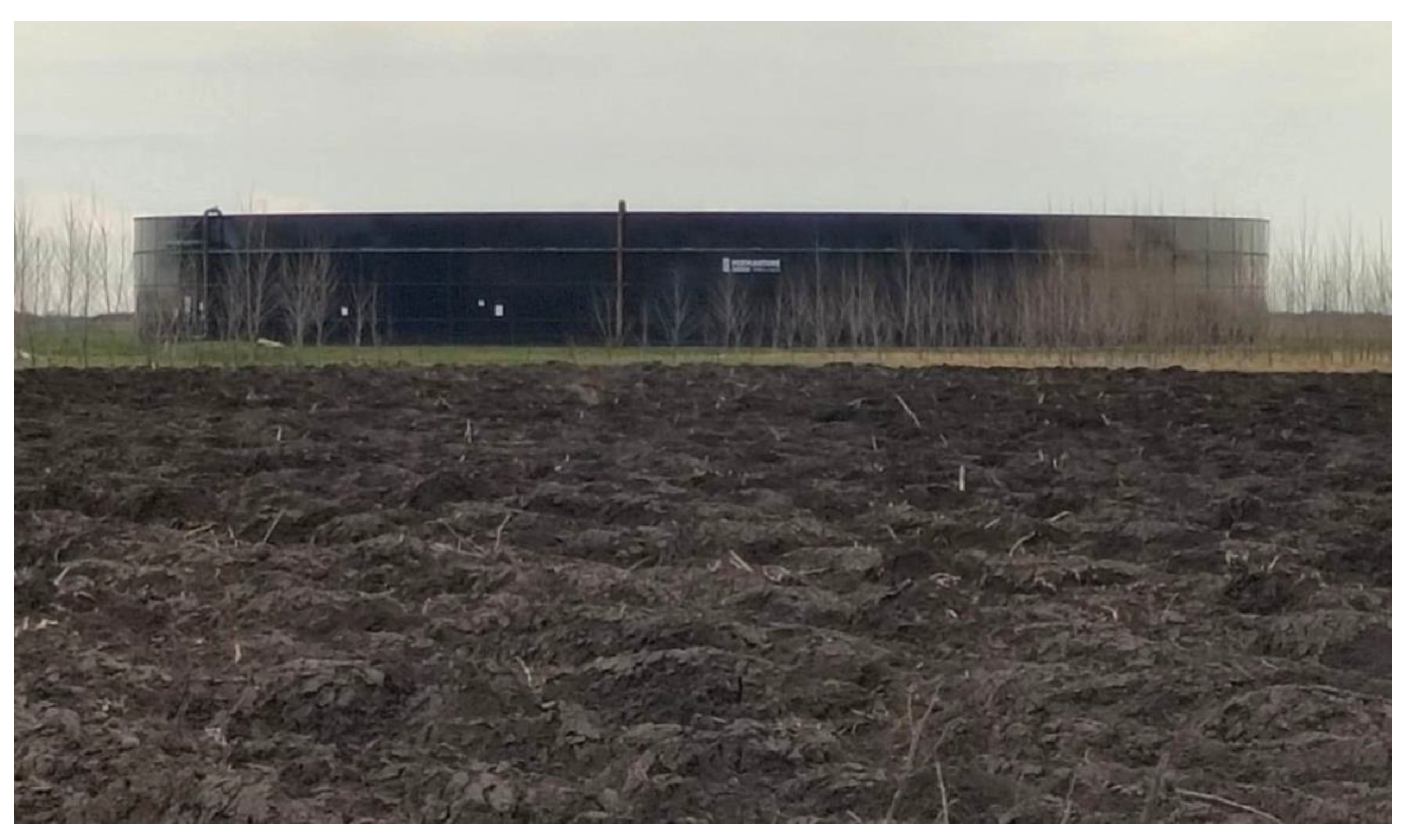
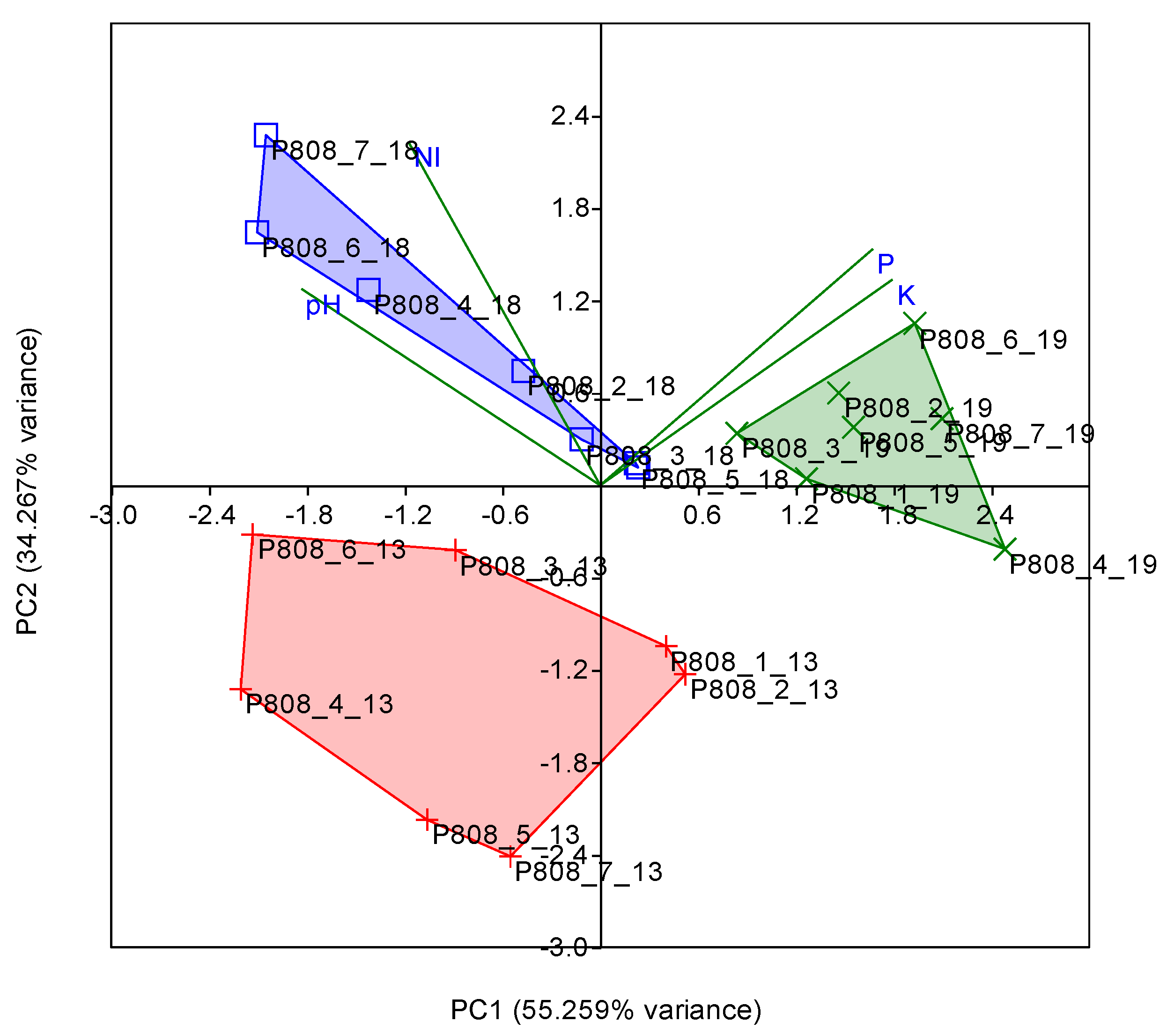
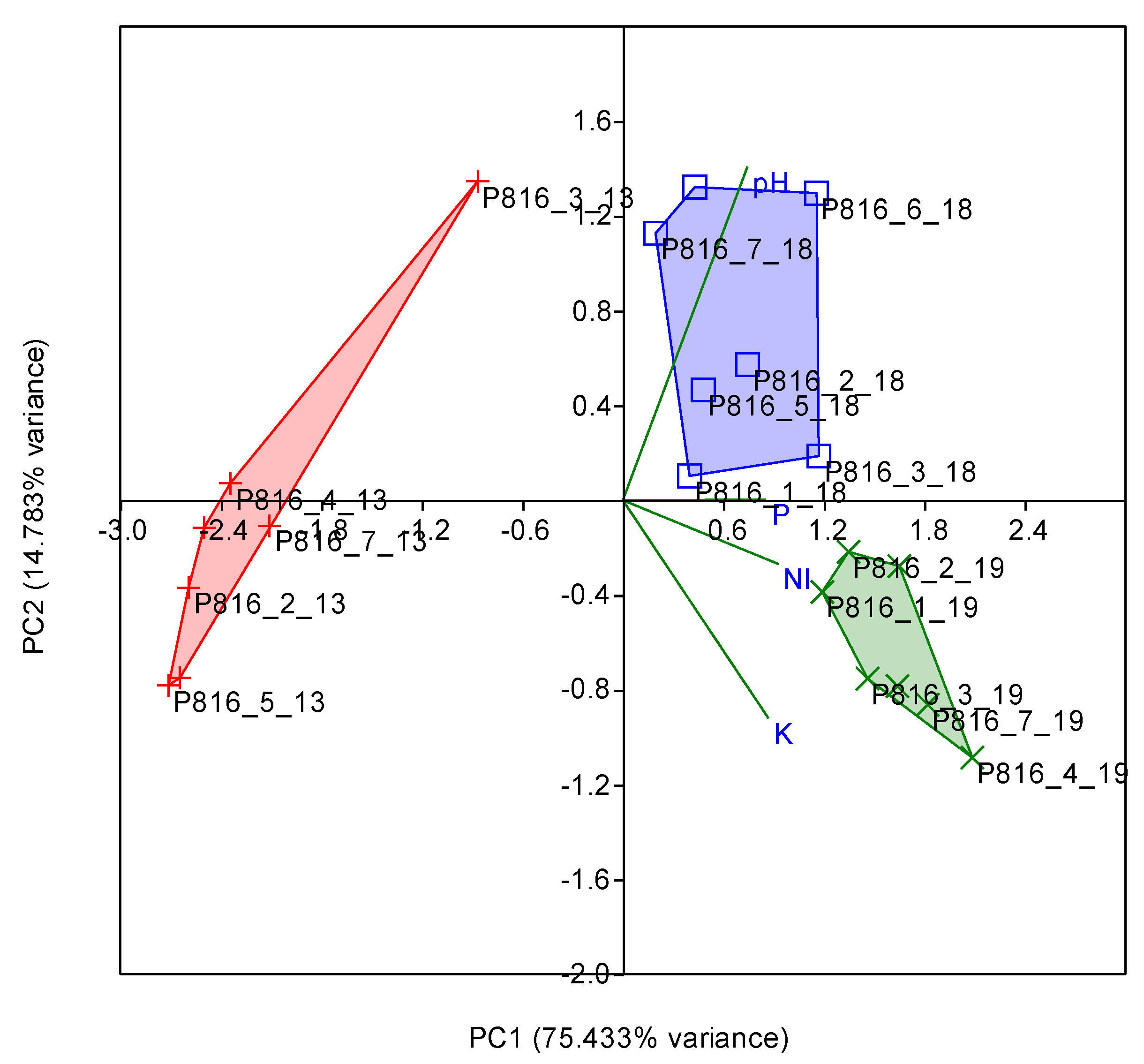
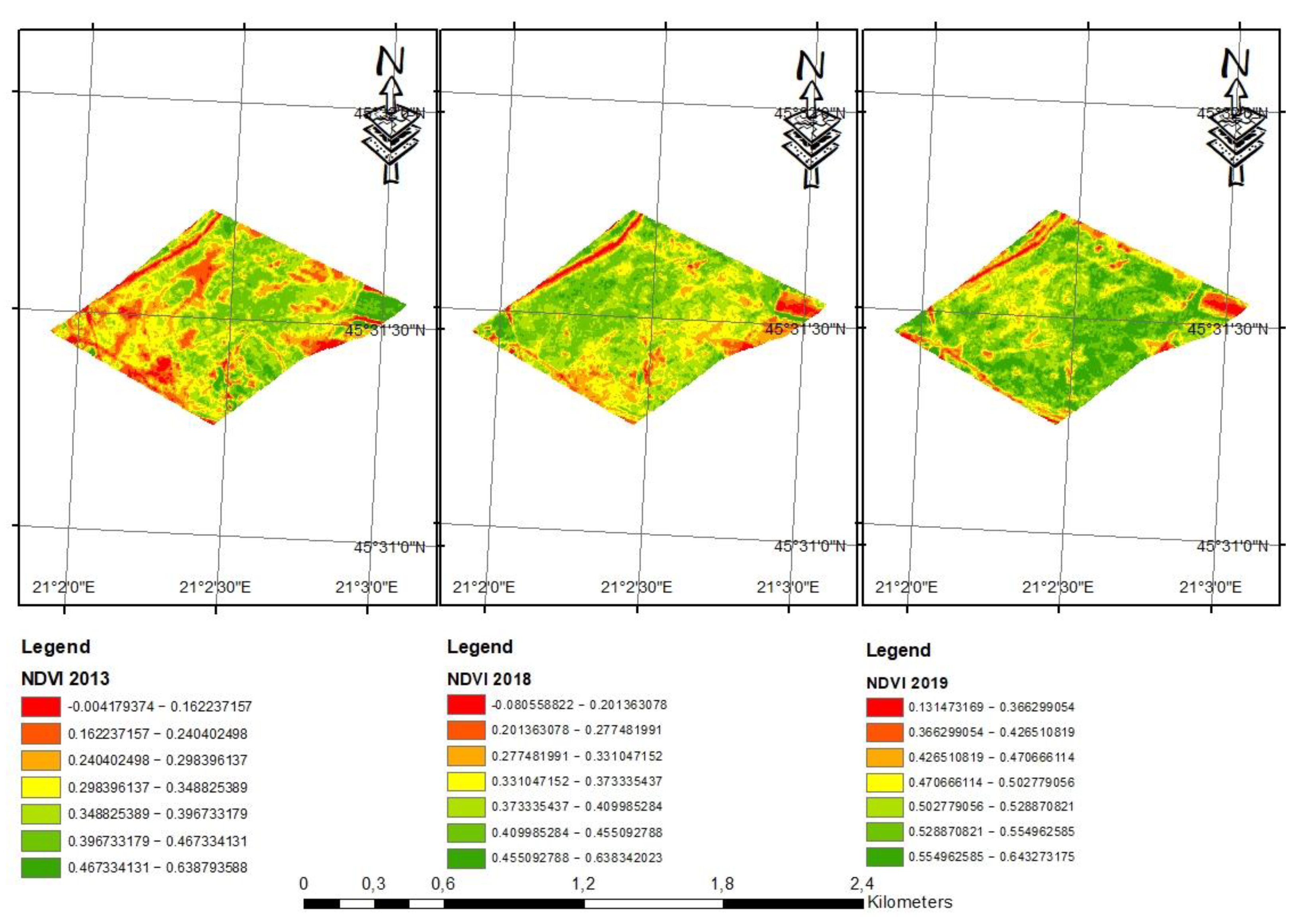
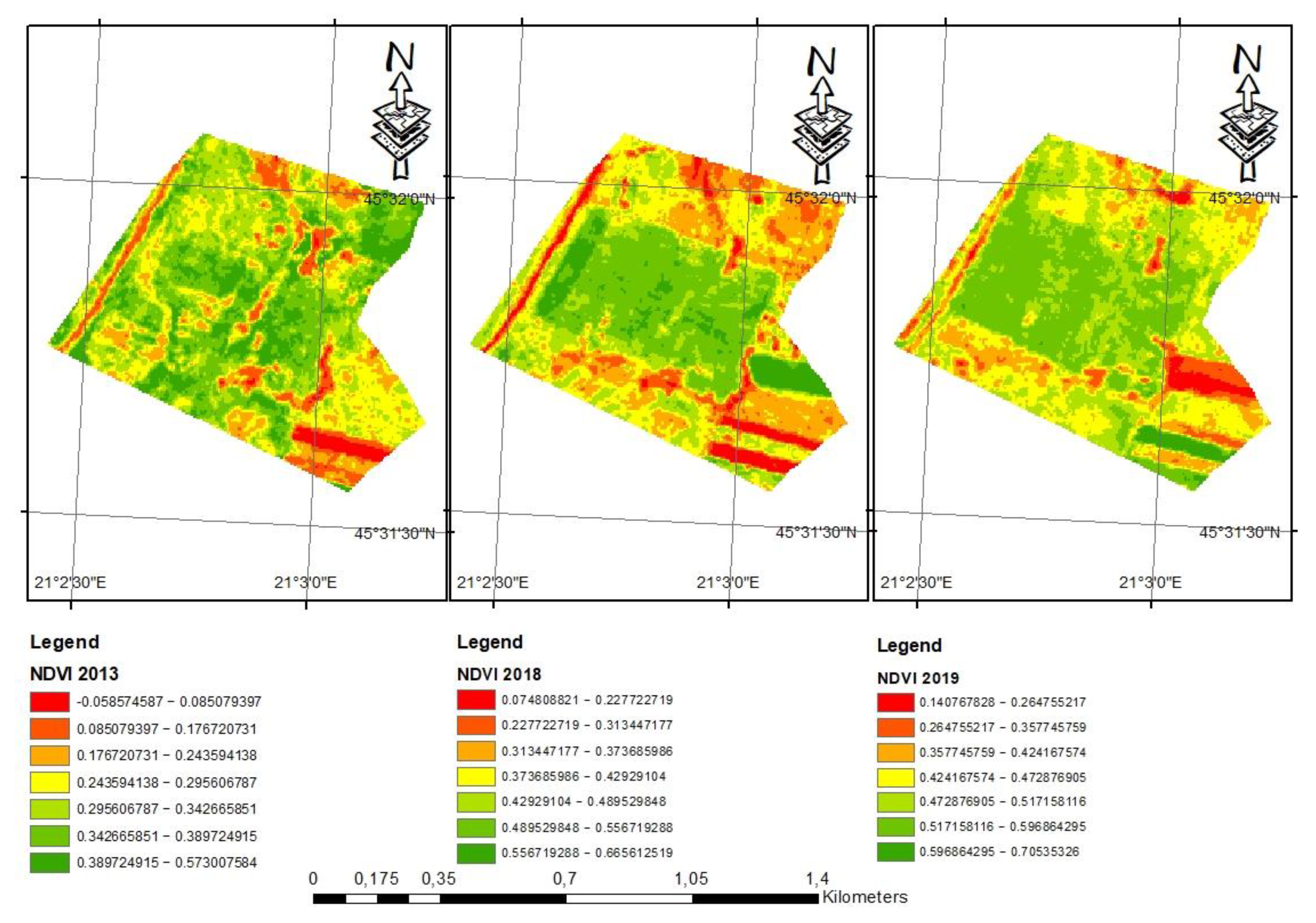
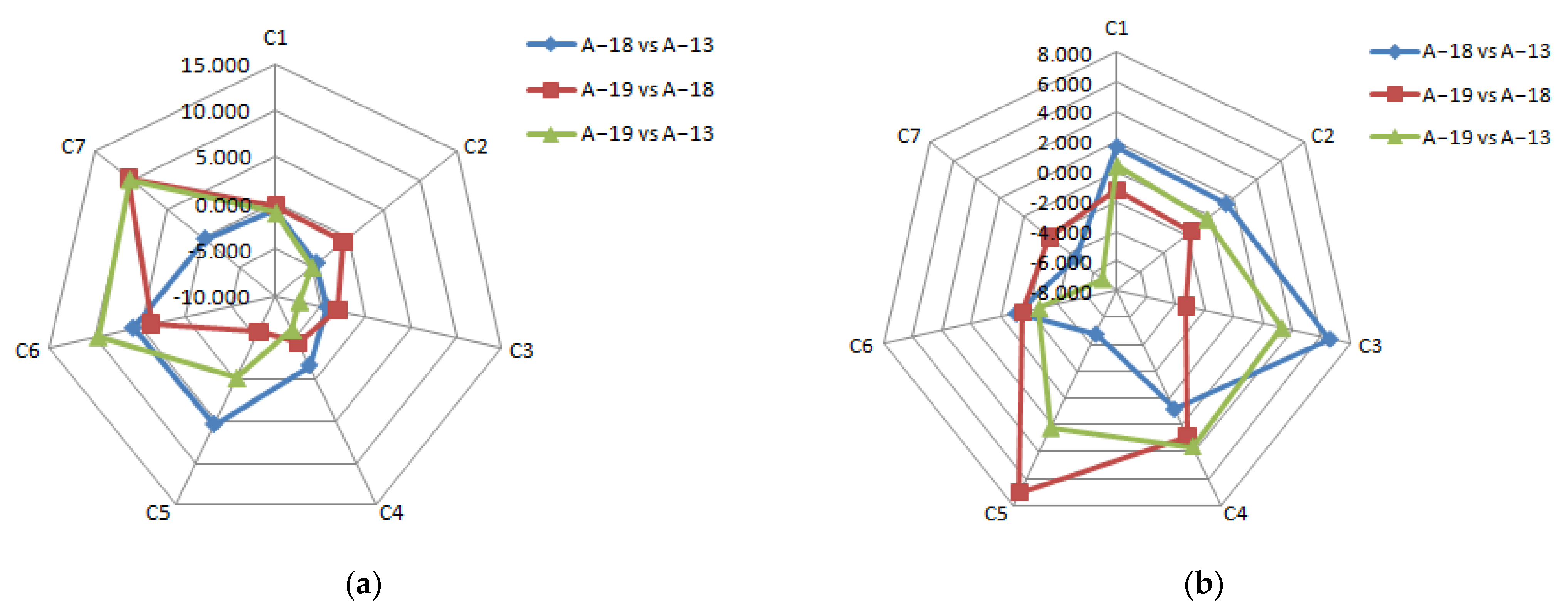
| Pig Sludge Quality Indexes | Measure Units | Values | Method/Standard |
|---|---|---|---|
| pH (H2O) | pH units | 7.76 | Potentiometric, according to PS-03 1 |
| T °C | 22.1 | ||
| Organic matter | % of dry substance | 49.26 | Calcinations at 600 °C, according to PL-01 1 |
| Moisture | % | 89.46 | Drying at 105 °C, according to PS-05 1 |
| Nitrogen total (Nt) | % | 0.10 | Kjeldahl, according to PS-08 1 |
| Soluble phosphorus (P2O5) | % | 0.048 | SR 11411-2:1998, according to PS-02 1 |
| Soluble potassium (K2O) | % | 0.10 | SR 11411/3-86, according to PS-06 1 |
| Soil Horizon | Depth (cm) | Properties |
|---|---|---|
| Aț | 0–8 | Medium clay (LL), dark gray-brown, glomerular structure |
| Ao | 8–35 | Medium clay (LL), brown, large glomerular structure |
| AB | 35–50 | Medium clay (LL), yellowish brown, small prismatic structure |
| Bv | 50–65 | Medium clay (LL), yellowish brown, small prismatic structure |
| BCkg | 65–82 | Medium clay (LL), yellowish brown with rust spots (≤5%), small prismatic structure, weakly effervescent |
| CBkacGo3 | 82–100 | Medium clay (LL), rusty yellow (16–30%), slightly effervescent |
| Parameters | Measurement Units | Soil Profile Horizon | |||||
|---|---|---|---|---|---|---|---|
| Aț | Ao | AB | Bv | BCkg | CBkacGo3 | ||
| Depth | cm | 8 | 35 | 50 | 65 | 82 | 100 |
| Coarse sand (2.0–0.2 mm) | % | 3.6 | 3.8 | 4 | 3.5 | 3.1 | 4.1 |
| Fine sand (0.2–0.02 mm) | % | 44.6 | 46.4 | 42.7 | 43 | 45.2 | 42.2 |
| Dust (0.02–0.002 mm) | % | 26.9 | 24.6 | 25 | 23.7 | 20 | 22.3 |
| Colloidal clay (under 0.002 mm) | % | 24.9 | 25.2 | 28.3 | 29.8 | 31.7 | 31.4 |
| Physical clay (under 0.01 mm) | % | 41.6 | 39.2 | 42.9 | 43.4 | 64 | 44.3 |
| Texture | LL | LL | LL | LL | LL | LL | |
| Specific density (SD) | g/cm3 | 2.63 | 2.63 | 2.62 | 2.63 | 2.65 | |
| Apparent density (AD) | g/cm3 | 1.42 | 1.47 | 1.51 | 1.53 | 1.53 | |
| Total porosity (TP) | % | 46.01 | 44.11 | 42.37 | 41.83 | 42.26 | |
| Aeration porosity (AP) | % | 13.49 | 11.33 | 7.94 | 6.79 | 7.07 | |
| Compaction degree (CD) | % | 6.22 | 10.18 | 14.61 | 16.11 | 15.75 | |
| Hygroscopicity coefficient (HC) | % | 5.84 | 5.91 | 6.64 | 6.99 | 7.43 | |
| Withering coefficient (WC) | % | 8.77 | 8.87 | 9.96 | 10.48 | 11.15 | |
| Field capacity (FC) | % | 22.9 | 22.3 | 22.8 | 22.9 | 23 | |
| Total capacity (TC) | % | 32.40 | 30.00 | 28.06 | 27.34 | 27.62 | |
| Useful water capacity (UWC) | % | 14.14 | 13.43 | 12.85 | 12.42 | 11.86 | |
| Hydraulic conductivity (HC) | mm/h | 3 | 2.2 | 1.8 | 1.1 | 1 | |
| Calcium carbonates | % | 0.86 | 1.28 | 1.92 | |||
| pH (H2O) | pH units | 6.47 | 6.69 | 7.27 | 7.93 | 8.21 | 8.51 |
| Humus | % | 4.22 | 3.18 | 2.63 | |||
| Nitrogen index (NI) | % | 3.62 | 2.80 | 2.46 | |||
| Humus reserve | to/ha | 47.94 | 126.21 | 59.57 | |||
| Soil horizon | Depth (cm) | Properties |
|---|---|---|
| Aț | 0–7 | Medium clayey loam (TT), dark gray-brown, glomerular structure |
| Ao | 7–25 | Medium clayey loam (TT), brown, large glomerular structure |
| AB | 25–40 | Medium clayey loam (TT), brown, small prismatic structure |
| Bvg | 40–55 | Medium clayey loam (TT), yellowish with rare rust spots (≤5%), small prismatic structure |
| BCg2 | 55–70 | Medium clayey loam (TT), slightly yellowish rust (6–15%), small prismatic structure |
| CBGo3 | 70–100 | Medium clayey loam (TT), yellowish rust (16–30%), small prismatic structure |
| Parameters | Measurement Units | Soil Profile Horizon | |||||
|---|---|---|---|---|---|---|---|
| Aț | Ao | AB | Bvg | BCg2 | CBGo3 | ||
| Depth | cm | 7 | 25 | 40 | 55 | 70 | 100 |
| Coarse sand (2.0–0.2 mm) | % | 0.3 | 0.3 | 0.5 | 0.3 | 0.3 | 0.4 |
| Fine sand (0.2–0.02 mm) | % | 39.1 | 39.2 | 38.4 | 35.5 | 35.5 | 35 |
| Dust (0.02–0.002 mm) | % | 27.5 | 27.7 | 27.3 | 28.7 | 26 | 28.7 |
| Colloidal clay (under 0.002 mm) | % | 33.1 | 32.8 | 33.8 | 35.5 | 38.2 | 35.9 |
| Physical clay (under 0.01 mm) | % | 55.9 | 55.4 | 50.3 | 52.9 | 54.4 | 54.4 |
| Texture | TT | TT | TT | TT | TT | TT | |
| Specific density (SD) | g/cm3 | 2.6 | 2.63 | 2.65 | 2.68 | 2.7 | |
| Apparent density (AD) | g/cm3 | 1.44 | 1.49 | 1.54 | 1.53 | 1.52 | |
| Total porosity (TP) | % | 44.62 | 43.35 | 41.89 | 42.91 | 43.70 | |
| Aeration porosity (AP) | % | 10.63 | 8.93 | 6.47 | 7.57 | 8.44 | |
| Compaction degree (CD) | % | 11.47 | 13.90 | 17.07 | 15.51 | 14.69 | |
| Hygroscopicity coefficient (HC) | % | 7.76 | 7.69 | 7.92 | 8.32 | 8.95 | |
| Withering coefficient (WC) | % | 11.64 | 11.53 | 11.88 | 12.48 | 13.42 | |
| Field capacity (FC) | % | 23.6 | 23.1 | 23 | 23.1 | 23.2 | |
| Total capacity (TC) | % | 30.98 | 29.09 | 27.20 | 28.05 | 28.75 | |
| Useful water capacity (UWC) | % | 11.97 | 11.57 | 11.12 | 10.63 | 9.78 | |
| Hydraulic conductivity (HC) | mm/h | 1.5 | 1.2 | 0.7 | 0.8 | 0.75 | |
| Calcium carbonates | % | 0.21 | 0.21 | ||||
| pH (H2O) | pH units | 6.42 | 6.48 | 6.68 | 7.04 | 7.35 | 7.64 |
| Humus | % | 4.59 | 2.13 | 1.22 | 0.55 | ||
| Nitrogen index | % | 3.91 | 1.83 | 1.07 | 0.50 | ||
| Humus reserve | to/ha | 46.27 | 57.13 | 28.91 | 8.42 | 140.72 | |
| P808 | P816 | ||||||||
|---|---|---|---|---|---|---|---|---|---|
| Trial | pH | P | K | NI | Trial | pH | P | K | NI |
| (ppm) | (%) | (ppm) | (%) | ||||||
| 2013 | |||||||||
| P808-1-13 | 6.51 | 22.20 | 310.00 | 2.96 | P816-1-13 | 6.10 | 29.00 | 201.00 | 2.64 |
| P808-2-13 | 6.48 | 25.60 | 301.00 | 2.92 | P816-2-13 | 6.04 | 28.60 | 216.00 | 2.58 |
| P808-3-13 | 6.69 | 21.80 | 286.00 | 3.16 | P816-3-13 | 6.63 | 34.60 | 189.00 | 3.16 |
| P808-4-13 | 6.71 | 10.20 | 230.00 | 3.17 | P816-4-13 | 6.11 | 35.30 | 176.00 | 2.65 |
| P808-5-13 | 6.51 | 15.50 | 230.00 | 2.96 | P816-5-13 | 5.93 | 29.90 | 235.00 | 2.48 |
| P808-6-13 | 6.82 | 20.10 | 249.00 | 3.27 | P816-6-13 | 5.90 | 35.60 | 218.00 | 2.45 |
| P808-7-13 | 6.44 | 10.60 | 250.00 | 2.89 | P816-7-13 | 6.10 | 37.90 | 200.00 | 2.64 |
| SE | ±0.05 | ±2.26 | ±12.62 | ±0.05 | SE | ±0.09 | ±1.41 | ±7.44 | ±0.08 |
| 2018 | |||||||||
| P808-1-18 | 6.48 | 28.10 | 315.00 | 3.40 | P816-1-18 | 6.50 | 48.30 | 320.00 | 3.21 |
| P808-2-18 | 6.60 | 29.40 | 308.00 | 3.56 | P816-2-18 | 6.59 | 56.60 | 287.00 | 3.24 |
| P808-3-18 | 6.52 | 35.50 | 293.00 | 3.46 | P816-3-18 | 6.49 | 69.10 | 305.00 | 3.17 |
| P808-4-18 | 6.74 | 32.50 | 286.00 | 3.71 | P816-4-18 | 6.80 | 48.30 | 276.00 | 3.07 |
| P808-5-18 | 6.48 | 35.60 | 300.00 | 3.40 | P816-5-18 | 6.59 | 51.20 | 311.00 | 3.10 |
| P808-6-18 | 6.84 | 33.20 | 273.00 | 3.82 | P816-6-18 | 6.84 | 55.60 | 286.00 | 3.30 |
| P808-7-18 | 6.90 | 36.60 | 290.00 | 3.90 | P816-7-18 | 6.75 | 42.60 | 280.00 | 3.13 |
| SE | ±0.06 | ±1.22 | ±5.31 | ±0.07 | SE | ±0.05 | ±3.21 | ±6.38 | ±0.03 |
| 2019 | |||||||||
| P808-1-19 | 6.48 | 45.60 | 325.00 | 3.11 | P816-1-19 | 6.52 | 48.20 | 390.00 | 3.49 |
| P808-2-19 | 6.52 | 53.30 | 336.00 | 3.16 | P816-2-19 | 6.55 | 50.40 | 372.00 | 3.59 |
| P808-3-19 | 6.55 | 49.60 | 312.00 | 3.18 | P816-3-19 | 6.48 | 50.60 | 429.00 | 3.48 |
| P808-4-19 | 6.30 | 58.30 | 325.00 | 2.96 | P816-4-19 | 6.38 | 60.40 | 416.00 | 3.83 |
| P808-5-19 | 6.48 | 69.10 | 299.00 | 3.11 | P816-5-19 | 6.41 | 58.60 | 396.00 | 3.59 |
| P808-6-19 | 6.53 | 63.30 | 349.00 | 3.16 | P816-6-19 | 6.60 | 45.50 | 389.00 | 3.87 |
| P808-7-19 | 6.44 | 54.50 | 350.00 | 3.09 | P816-7-19 | 6.44 | 54.50 | 412.00 | 3.77 |
| SE | ±0.031 | ±3.04 | ±7.07 | ±0.02 | SE | ±0.02 | ±2.06 | ±7.33 | 0.06 |
| NDVI Class | 2013 | 2018 | 2019 | |||
|---|---|---|---|---|---|---|
| Area (m2) | NDVI 2013 | Area (m2) | NDVI 2018 | Area (m2) | NDVI 2019 | |
| C1 | 23,153.95 | 0.118941 | 15,717.02 | 0.155014 | 12,851.99 | 0.333843 |
| C2 | 73,893.17 | 0.207648 | 30,117.46 | 0.248648 | 23,533.72 | 0.400956 |
| C3 | 121,440.4 | 0.272589 | 78,506.04 | 0.308143 | 47,126.06 | 0.453363 |
| C4 | 162,656.4 | 0.324222 | 146,258.1 | 0.354927 | 103,053.6 | 0.489111 |
| C5 | 161,984 | 0.372804 | 216,130.4 | 0.392646 | 159,579.5 | 0.516977 |
| C6 | 122,351.7 | 0.421276 | 180,715.8 | 0.427479 | 218,380.9 | 0.541779 |
| C7 | 24,394.34 | 0.511384 | 22,481.09 | 0.481683 | 125,483.2 | 0.568601 |
| NDVI Class | 2013 | 2018 | 2019 | |||
|---|---|---|---|---|---|---|
| Area (m2) | NDVI 2013 | Area (m2) | NDVI 2018 | Area (m2) | NDVI 2019 | |
| C1 | 11,936.34 | 0.035160 | 28,536.97 | 0.182125 | 16,215.20 | 0.222648 |
| C2 | 43,250.92 | 0.141731 | 56,581.01 | 0.289822 | 40,472.44 | 0.332932 |
| C3 | 68,502.37 | 0.216512 | 134,458.90 | 0.350527 | 101,754.00 | 0.414478 |
| C4 | 120,301.90 | 0.272824 | 128,399.00 | 0.408898 | 156,796.70 | 0.462809 |
| C5 | 142,063.00 | 0.320525 | 94,327.74 | 0.470395 | 164,844.70 | 0.509165 |
| C6 | 152,217.20 | 0.365342 | 141,099.00 | 0.528135 | 125,760.50 | 0.545250 |
| C7 | 77,805.43 | 0.41117 | 32,717.55 | 0.598957 | 10,328.02 | 0.663606 |
Publisher’s Note: MDPI stays neutral with regard to jurisdictional claims in published maps and institutional affiliations. |
© 2022 by the authors. Licensee MDPI, Basel, Switzerland. This article is an open access article distributed under the terms and conditions of the Creative Commons Attribution (CC BY) license (https://creativecommons.org/licenses/by/4.0/).
Share and Cite
Bertici, R.; Dicu, D.; Herbei, M.; Sala, F. The Potential of Pig Sludge Fertilizer for Some Pasture Agricultural Lands’ Improvement: Case Study in Timiș County, Romania. Agronomy 2022, 12, 701. https://doi.org/10.3390/agronomy12030701
Bertici R, Dicu D, Herbei M, Sala F. The Potential of Pig Sludge Fertilizer for Some Pasture Agricultural Lands’ Improvement: Case Study in Timiș County, Romania. Agronomy. 2022; 12(3):701. https://doi.org/10.3390/agronomy12030701
Chicago/Turabian StyleBertici, Radu, Daniel Dicu, Mihai Herbei, and Florin Sala. 2022. "The Potential of Pig Sludge Fertilizer for Some Pasture Agricultural Lands’ Improvement: Case Study in Timiș County, Romania" Agronomy 12, no. 3: 701. https://doi.org/10.3390/agronomy12030701
APA StyleBertici, R., Dicu, D., Herbei, M., & Sala, F. (2022). The Potential of Pig Sludge Fertilizer for Some Pasture Agricultural Lands’ Improvement: Case Study in Timiș County, Romania. Agronomy, 12(3), 701. https://doi.org/10.3390/agronomy12030701






